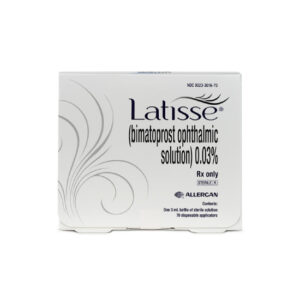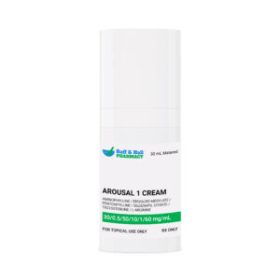Bimatoprost Eyelash Solution (3 mL) †
Bimatoprost Eyelash Solution (5 mL) †
† commercial product
A sterile, preservativefree topical formulation including 0.03% bimatoprost, a synthetic prostaglandin F₂α analog meant for nightly dermal use to the upper eyelid margin. According to an individual, patient-specific prescription should be considered an unapproved drug product because it is not produced on a commercial or FDAapproved basis.
Designed to lengthen, thicken, and enhance lashes, bimatoprost eyelash solution is available in 3 mL and 5 mL singlepatient containers with disposable applicators. Although therapeutic response varies and could recede following stopping, clinical trials of the reference 0.03% solution showed noticeable lash improvement within sixteen weeks.
Prescribers should advise patients about possible local side effects, including hyperemia, periocular skin darkening, iris pigment alterations, and periorbital fat loss, as well as the to prevent undesired hair growth on nearby skin, careful application approach is necessary.
Although systemic adverse reactions are uncommon because systemic exposure following dermal administration is little, good medical history—for instance, glaucoma medication or inflammatory eye condition—remains vital.
Healthcare practitioners acquainted with prostaglandin-based treatments and the extra regulatory issues attached to 503A compounding should prescribe and follow this compounded composition.
After transdermal absorption, bimatoprost is an amide prodrug that binds specifically to the prostamide FP receptor complex expressed in epithelial cells and hair follicle dermal papillae. Activation of these Gprotein-coupled receptors increases intracellular free calcium, upregulates mitogenactivated protein kinase signalling, and finally encourages transition from telogen to anagen while extending the anagen interval itself.
Accelerated matrix keratinocyte proliferation and enhanced synthesis of keratin-associated proteins have been discovered in histochemical research, which corresponds with clinically seen increases in lash length and diameter. Bimatoprost at the same time enhances melanogenesis inside follicular melanocytes, therefore explaining the darkening effect seen often by patients.
Dermal application generates little conjunctival hyperemia, unlike ophthalmic administration, since eyelid skin has a lower vascular FPreceptor density. Ten minutes is when peak plasma levels (under 0.1 ng/mL) occur, and the molecule is rapidly hydrolyzed to an inert acid metabolite with an elimination halflife less than Forty minutes; thus, it is unlikely that there would be systemic pharmacodynamic consequences including decreased intraocular pressure.
Notably, receptor desensitization has not been proven over twelve-month continuous use, therefore supporting the chronic nightly regimen required for lash maintenance. Still, exact molecular intermediates are still not thoroughly understood, and interindividual variation indicates the possible presence of genetic or epigenetic modulators of follicular FP receptor expression.
People who are allergic to bimatoprost or any ingredients in its formula should not use the eyelash solution. It’s also important for doctors to be careful before prescribing it to people with eye inflammation. Conditions like uveitis, iritis, or cystoid macular edema can get worse with this treatment, so it’s best to wait until the inflammation has cleared.
Patients who have had complicated eye surgeries, those with damaged lenses, or those who’ve had certain eye diseases like herpetic keratitis should use it with extra care. In glaucoma patients already using eye drops that contain prostaglandin analogues, using bimatoprost on the skin around the eyes might still affect eye pressure or cause more redness, so doctors should monitor these cases closely.
For people wearing contact lenses, it’s advised to remove them before applying the solution and wait at least 15 minutes before putting them back, especially if the other eye drops contain preservatives like benzalkonium chloride.
Dermal dosing produces plasma concentrations many orders of magnitude less than those needed to affect cytochrome P450 isozymes; as such, clinically significant systemic drug-drug interactions are probably unlikely.
Still, additive local side effects might happen when prostaglandin analogues are used simultaneously to the ocular surface, therefore raising the frequency of conjunctival hyperemia, pruritus, and periocular pigmentation.
Although combination therapy can complicate causality assessment for periocular skin changes, betaadrenergic antagonists, carbonic anhydrase inhibitors, or alpha agonists used ophthalmologically do not seem to alter bimatoprost’s follicular effects.
Although bimatoprost itself has no effects, polypharmacy in glaucoma highlights the necessity of extensive medication reconciliation as systemic absorption of topical βblockers has been shown to exacerbate hypotension and bradycardia.
Although concurrent use of skin-irritating products might theoretically increase local erythema, no interaction studies including dermal bimatoprost and dermatologic agents, such as retinoids, have been done.
Although theoretical interaction with nonsteroidal antiinflammatory medicines exists because bimatoprost is a weak prostaglandin F₂α analogue, present pharmacovigilance databases have not confirmed reduced effectiveness in people utilizing topical NSAIDs.
Mild, brief itching or erythema at the application site—reported in up to 4% of individuals—is the most often seen side effect; signs generally decrease with ongoing application or better applicator cleanliness.
Mediated by enhanced melanogenesis, periocular skin and lash hyperpigmentation progresses slowly and might last even after cessation. When the solution moves beyond the lid margin, hypertrichosis spreading to the malar or temporal areas has been noted.
Although uncommon, conjunctival hyperemia, punctate keratitis, and dry eye feeling call for investigation to rule out accidental intraocular exposure.
Patients should be advised to stop use and get medical review if they start to have severe ocular pain, vision abnormalities, or notable inflammation.
Bimatoprost is categorized as Pregnancy Category C since animal reproduction studies have shown dose-dependent fetal loss and skeletal changes at dosages far over human ocular exposure.
Dermal application of 0.03 % solution produces systemic exposures very under those linked with negative developmental results in rats and rabbits; but, the margin of safety is high. For the first trimester, when prostaglandin analogues might theoretically affect uterine tone, safety is still uncertain.
While animal models show excretion into milk following parenteral dosing; lactating women should Weigh the aesthetic advantage against unknown baby exposure.
Bimatoprost Eyelash Solution is chemically stable at controlled room temperature (20 – 25 °C; and should be safeguarded from excessive heat or direct sunlight.
Refrigeration is unnecessary and may lead to increased viscosity that impairs uniform dispensing. The container should remain tightly closed to minimize oxidative degradation and microbial ingress.
Under recommended conditions, unopened vials retain potency until the labelled beyond-use date assigned by the compounding pharmacy, typically six months from preparation.
Opened containers should be discarded after twelve weeks to mitigate contamination risk.
- U.S. Food and Drug Administration. (2021). Latisse (bimatoprost) [Package insert]. https://accessdata.fda.gov/drugsatfda_docs/label/2021/022369s014lbl.pdf
- Smith, S., Fagien, S., Whitcup, S. M., et al. (2012). Eyelash growth in subjects treated with bimatoprost: A multicenter, randomized study. Journal of the American Academy of Dermatology, 66(1). https://doi.org/10.1016/j.jaad.2011.10.019 – LinkOpens in New Tab
- Review of Optometry. (2016, March 4). Practice Pearl of the Week: Glaucoma meds- side effects and contraindications. https://www.reviewofoptometry.com/email/pearl198.html – LinkOpens in New Tab
- UK Clinical Pharmacy Association. (2023). Bimatoprost-Perioperative medicines handbook. https://periop-handbook.ukclinicalpharmacy.org/drug/bimatoprost/ – LinkOpens in New Tab
- Drugs..com. (2025, January 11). Bimatoprost ophthalmic side effects. https://www.drugs.com/sfx/bimatoprost-ophthalmic-side-effects.html – LinkOpens in New Tab
- Drugs..com. (2025). Bimatoprost ophthalmic use during pregnancy. https://www.drugs.com/pregnancy/bimatoprost-ophthalmic.html – LinkOpens in New Tab
- DailyMed. (2024). Bimatoprost ophthalmic solution: Dosage and administration. https://dailymed.nlm.nih.gov/dailymed/fda/fdaDrugXsl.cfm?setid=27bef7e1-750a-4ac1-ab5f-e4c0121ffcbc – LinkOpens in New Tab
- Chatterjee, A., & Sarkar, S. (2008). Comparative stability of bimatoprost 0.03 % and latanoprost 0.005 %. BMC Ophthalmology, 8, 11. https://doi.org/10.1186/1471-2415-8-11 – LinkOpens in New Tab
- Goldberg, D. F., et al. (2013). Patient-reported outcomes after bimatoprost for eyelash hypotrichosis. Aesthetic Surgery Journal, 33(6), 789-798. https://doi.org/10.1093/asj/sjt050 – LinkOpens in New Tab
- Mahadevan, R., & Singh, P. (2014). Bimatoprost-induced iris hyperpigmentation: Case report. Clinical Therapeutics, 36(2), e7-e9. https://cdn.mdedge.com/files/s3fs-public/CT104002007_e.PDF – LinkOpens in New Tab
- Day, D. G., Jones, S. A., & Whitcup, S. M. (2003). Systemic pharmacokinetics of bimatoprost 0.03 % solution. Investigative Ophthalmology & Visual Science, 44(5), 2173. https://iovs.arvojournals.org/article.aspx?articleid=2418003 – LinkOpens in New Tab
- Allergan. (2011). Lumigan (bimatoprost) ophthalmic solution 0.03 % [Package insert]. https://accessdata.fda.gov/drugsatfda_docs/label/2011/021275s022lbl.pdf
- Drugs..com. (2025). Bimatoprost monograph for professionals. https://www.drugs.com/monograph/bimatoprost.html – LinkOpens in New Tab
- ChemIgnition. (2025). Latanoprost vs bimatoprost: Key differences for formulators. https://chemignition.com/blog/latanoprost-vs-bimatoprost-key-differences – LinkOpens in New Tab
- Singh, K. (2023). Glaucoma myth busters: Prostaglandin analogues and inflammation. Glaucoma Physician. https://glaucomaphysician.net/issues/2023/march/glaucoma-myth-busters-myths-about-prostaglandin-analogues-and-inflammation/ – LinkOpens in New Tab
- Harris, M. (2009, January 5). Glaucoma meds repurposed to grow longer lashes. Wired. https://www.wired.com/2009/01/glaucoma-meds-h – LinkOpens in New Tab
- CVS Health. (2014). Latisse prescribing information.
- [nolink]https://www.cvs.com/bizcontent/minuteclinic/wso_slotcontent/services/wellness – LinkOpens in New Tabphysicals/latisse-prescribing-info.pdf[/nolink]
- AppliancesFirst. (2025). The truth about bimatoprost: Do you need to refrigerate it? https://appliancesfirst.com/does-bimatoprost-need-to-be-refrigerated/





